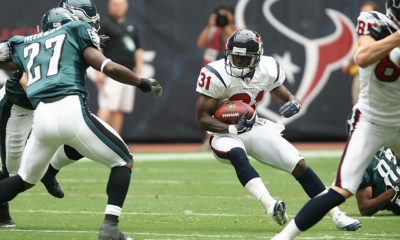
To this day, The XFL remains the most ill-fated business venture of Vince McMahon’s career. When it debuted in 2001, it was quite clearly not going to have any kind of long-term success, due to public perception more than anything else. At the time, professional wrestling was one of, if not the most popular shows on television, and McMahon had no reservations about opening the league with his guns blazing, which hurt the standing of the league more than he probably foresaw. Despite the initial high ratings, the league crumbled under the weight of its own fanfare, becoming a punchline in seemingly no time at all. It folded after just one season of activity.
But what if it wasn’t all that bad? What if McMahon was on to something, and was simply ahead of his time? Looking at The XFL in hindsight, we can observe a league that certainly had its relative successes along with its more notorious detriments. In fact, some of the things employed by The XFL are actually used in today’s NFL broadcasts, making the league influential in that regard. So, did The XFL really deserve all of the criticism that it received?
Ranked below are 10 things The XFL got wrong, and 5 things they actually got right:
15. Wrong: Nicknames On The Backs Of Jerseys
The XFL may have been slightly cavalier about this move, which gave the league a negative stigma right off the bat. There is no doubt that it was a major talking point that drew a ton of attention to the league at the time, but it was also one of the hallmarks that made it disposable to the fans of The NFL, and more “serious” football organizations.
By far the most notable player to take advantage of this was Rod Smart, who donned the words “He Hate Me” as the nickname on the back of his jersey. There was definitely some campy fun involved with this, but when the league started to lose ratings in the early going, this only added more fuel to the fire. Smart may have gotten the last laugh, however, playing in a Super Bowl with the Carolina Panthers in The NFL just a few years later.
14. Wrong: Having Only 8 Teams
There is no doubt that The XFL needed a bit more clout with the amount of teams to make any real impact, or to compete with The NFL. While some of the markets were interesting for the time (Los Angeles, who had just lost The Rams, and Las Vegas), it wasn’t enough to compensate for the fact that there just wasn’t enough of a “big picture” feel to the league.
Of course, the talent was spread so thin in the one and only season, that having more teams wasn’t a feasible possibility. Had the league been able to stay around, more teams likely would have been added to the ranks. It wasn’t the biggest detriment to The XFL, but ideally any league would like to have more than 8 teams to keep the intrigue level high and create more stars.
13. Right: Opening Scrum For The Ball
Instead of a coin toss, The XFL had one player from each team oppose each other in a “scrum” for the football placed at midfield and whichever player was the first to come up with the football got the choice to receive or defer the kickoff. This was actually highly entertaining, and falls in line with the physical nature of the game. It’s the kind of innovative thinking that McMahon and company were able to get right, and present an alternative attitude in contrast to the more rigid NFL style.
It is unlikely that we will see this implemented in any other league, but it did demonstrate that if nothing else, The XFL was going to be different than other football leagues that had come about before them. You could argue that this further risked injury, but it was only marginal, and a great addition to the pre-kickoff routine.
12. Wrong: 38-Man Rosters
With all of the conversation and debate surrounding injuries and concussions in football today, this one definitely hasn’t aged well. There are some pundits calling for The NFL to increase rosters past the 53-man mark, so a considerably lower number of 38 players looks paltry in comparison.
The idea was that some players would be able to play on both sides of the ball, and that coaches would have to be more strategic in how they used their players, but there is no way that this could have reasonably worked over a long period of time. Football teams at any level need sufficient depth, because players are liable to come out of the game on any given play. Interesting idea in theory, but not at all practical.
11. Wrong: Standardized Salaries
XFL players weren’t paid nearly as much as their NFL counterparts, but everyone expected that. What they didn’t expect was for players to receive standardized salaries by position, with a bonus depending on whether or not their team won the game. Such a pay scale limits incentives, and allows for players to coast along if they so chose to.
Obviously, a league in its first (and only) year of operation didn’t have the capital, or established ownership that would allow for players to make elite money. But having some kind of system that rewarded play, instead of treating every player as an equal may have allowed for a more competitive product, and interest level from prospective players gong forward. Instead, many players just cashed in week-by-week, with little reason to go above a minimum effort level.
10. Right: Camera Angles
Watching an XFL game was a football experience like nobody had ever seen before. It has to be remembered that in 2001, the way football was presented on television was still in a traditional manner, with limited camera angles and looks on the field. The XFL was able to change that by positioning the cameras in various levels on the sidelines, and even on the field, into the offense’s huddle.
It’s something that has been adopted much more in today’s presentation of the game, and the sport is all the better for it. Now, we can see every bone-crushing hit, and spectacular catch from a variety of different, high-definition angles that show every aspect of the play. The XFL was influential in this regard, and their contributions shouldn’t be ignored. Unfortunately, it may have been slightly ahead of its time in 2001.
9. Wrong: Promotion Of The Product
Presenting The XFL as an alternative to The NFL, and having the public perception of the product not veer into the realm of “trashy” was always going to be a balancing act. The sheer involvement of McMahon in the league caused many people to question it from the beginning. When the league ran commercials and advertising which favored a more risqué, late-night kind of promotion, it ultimately didn’t help the standing.
From McMahon’s perspective, it must have made sense, and you could argue that there was little else he could do to set it apart from The NFL immediately. But the world was much different in 2001 than it is today, and such “action move-like” promotion made it disposable to much of the public, and fans largely considered the league a novelty.
8. Wrong: On-Field Talent
Again, there’s not much that McMahon could have done about this at the time, but looking back on some of The XFL games, they really weren’t a representation of the best that football had to offer from a talent perspective. While some players, such as quarterback Tommy Maddox, eventually had a large degree of success in The NFL, a fair portion of the league were nothing more than scab players; NFL castoffs who were looking to make a quick buck playing a sport they were familiar with from the college game.
This is something that no doubt would have improved if the league had stayed intact, but at a time when The NFL was growing by leaps and bounds into a passing-oriented, highlight-reel brand of football, there was little The XFL could do to compete. The players in the NFL were simply better, and after the initial intrigue of The XFL wore off, there wasn’t much on the field to keep viewers coming back.
7. Right: Embraced Gambling
Through the advent of fantasy gaming, along with looser regulations on traditional betting on games, football has flourished in the proceeding years after The XFL’s demise. The league made no bones about acknowledging the point spreads and odds for each game. In a time where this was largely taboo in a public setting, it was a shock to many who were used to the traditional NFL view on gambling.
This too may have been ahead of its time, but as we can all observe in the present day, gambling is a huge part of The NFL, and it is embraced much more thoroughly than it was years earlier. This had allowed another dimension in the sport, with any fan easily being able to wager on the product, whether through fantasy gaming, or betting against a spread. The XFL needs to be considered an influence on this as well, as it’s such a large part of football today.
6. Wrong: Full Bump-And-Run Coverage
This was nothing more than just a stupid rule. Allowing defensive backs to make contact with a receiver all the way down the field wasn’t conducive to points being put up on the scoreboard, which would have helped the league reach out to a new audience. As a result, many of the games were low-scoring, which hurt the fan’s interest in the early going.
There are some aspects of a traditional football game that are best left in place, particularly when it concerns the general viability of the offense, creating more highlight reel plays. The XFL didn’t recognize this, and while it wasn’t the biggest detriment to the league, it certainly didn’t help.
5. Wrong: Mandatory 2-Point Conversion
This seems to come up every other year or so as a possibility for an NFL rule change. The issue with it, as it showed itself in The XFL, is that games become lopsided in awkward ways in the middle of the game. This can mean less excitement at the end of the game, where the game is at its most important from a viewership perspective.
Forcing teams to go for 2 points after a touchdown just isn’t a good idea. It creates more excitement for one moment, and then can negatively affect the competitiveness of a game for the rest of regulation. The XFL tried to be different in this regard, but it was just another ham-fisted attempt to separate itself from The NFL.
4. Right: Mic’d Up Players
OK, this was just an awesome part of the presentation of The XFL. The league spared no expense allowing the viewer to hear the coach-to-quarterback call in the huddle from the headset, or talking about strategy on the sidelines. It was a fresh take on the flow and dynamic of a football game, and was a great idea to create an alternative vibe from The NFL.
While we see more of this in today’s NFL, it still can’t compare to the level that was exhibited by The XFL back in 2001. It truly was a revolutionary aspect of their broadcasts. To be able to clearly hear the calling of plays, sideline banter, and general strategy of the team was something that should have implemented in the game all along. It gave fans a unique look into the inner-workings of the game, something that had a lot of replay value.
3. Wrong: No Fair Catch Rule
Here’s another rule that never would have made it in today’s perception of the sport. Fair catches reduce the odds of potentially serious injury, and blindside hits that yield a higher chance of a concussion. Obviously, this issue wasn’t as prevalent in 2001, so it makes sense why the league would at least consider it as a standard rule.
Unfortunately, it hasn’t held up well, and actually helps keep The XFL in the negative light that it has been cast in for the past 15 years or so. Such disregards for player safety just don’t hold up in today’s world. Again, at the time it probably seemed like an innovative idea that could be used as a hallmark of the league. Today however, it seems like a bad gimmick at best, and a significant safety hazard at worst.
2. Wrong: Wrestling Product On The Broadcast
For as many people that are fans of professional wrestling, there are just as many who aren’t. This was particularly true during the Attitude Era, which was still in force when The XFL opened in 2001. This led to McMahon being viewed as nothing more than a figurehead for the perceived “clown show” that was professional wrestling. He was divisive back then, and many people never believed that he could successfully operate a professional football league.
As a result, many people tuned him out from the beginning. It didn’t help that the broadcasters for the games included wrestling staples like Jim Ross, Jerry Lawler, Jesse “The Body” Ventura, along with appearances from The Rock and others. While this was an entertaining aspect of The NFL, the average person associated it too closely with The WWE product that was being shown as the time. Because of this, most people never gave The XFL a chance to begin with, and the league was doomed for failure the minute it was enacted.
1. Right: General Influence On The NFL
Contrary to many of the opinions surrounding the league, they actually had distinct impact on The NFL, especially in the way the game is presented on television. Before The XFL, the broadcasts of The NFL were decidedly bland, and in need of a facelift. The 21st century was upon us, and the stale old way of doing things wasn’t going to fly for much longer. The NFL took notice, and applied the best aspects of The XFL broadcasts to their own.
Now, anytime we watch an NFL game in the modern day, we can observe sky-cams, mic’d up players, and a variety of sideline and on-field views. It makes the game feel like more of an overall experience, and makes the prospect of wading through traffic to get a game live, more obsolete. The XFL can be directly credited for this, as they were the precedent to show that the television experience of football could be massively upgraded.
Unleash the Action: Sign up for XFL Insider and Fuel Your Passion for Football!

USFL and XFL Merger: A Deep Dive into the Historic Collaboration
Latest Podcast
-


XFL Podcast
/ 1 year agoXFL-USFL Merger Insights: Houston’s Future, Draft News, Player Movement – Ep. 216
Welcome to Episode 216 of the “XFL Week In Review,” your premier destination for...
By Mark Perry







